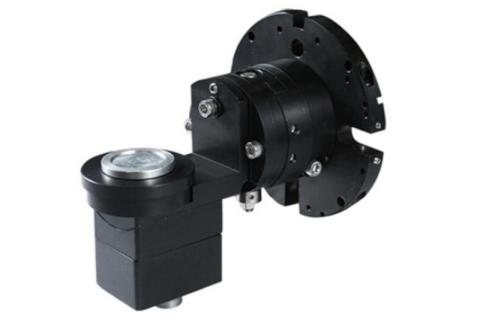
- Home
- >
News
Dandong Tongda Technology Co., Ltd. is a high-tech enterprise from China specializing in X-ray analysis and NDT equipment. With core competitiveness in XRD, we provide precise tools for global research and industry.
In the fields of materials science and industrial testing, precise sample analysis relies on reliable instruments. The rotating sample stage produced by Dandong Tongda Technology Co., Ltd. is precisely such a critical accessory dedicated to enhancing the quality of X-ray diffraction (XRD) analysis. In X-ray diffraction analysis, the characteristics of the sample itself often pose challenges. For example, when the grains are excessively coarse, the material exhibits significant texture (or "preferred orientation," meaning the grains are not randomly arranged), or the sample has specific crystal habits (crystal growth patterns), obtaining diffraction data that is statistically representative and truly reflects the overall material properties becomes difficult. When measuring such samples with traditional static sample stages, the diffraction intensity may be distorted due to the aforementioned factors, affecting the accuracy of phase identification, texture analysis, and other evaluations. The core design philosophy of Tongda Technology's rotating sample stage is to address these challenges by enabling smooth rotation of the sample within its own plane. Core Function: Eliminating Orientation Errors and Enhancing Data Reliability The working principle of this rotating sample stage is intuitive and effective. By driving the sample to rotate continuously or in a stepwise manner, it ensures that the X-ray beam covers more grains with different orientations on the sample during irradiation. The main advantages of this approach are: Effective Reduction of Measurement Errors: Through the rotation averaging effect, it significantly mitigates measurement deviations caused by coarse grains or preferred orientation, making the diffraction data more representative of the material's overall properties. Ensuring Result Reproducibility: Whether the sample itself has texture or not, it guarantees good reproducibility of diffraction intensity across multiple measurements or between different laboratories, enhancing the reliability and comparability of data. Simplified Sample Preparation Requirements: It reduces the stringent demands for perfect sample preparation to a certain extent, improving analysis efficiency. Technical Specifications: Precision Control and Flexible Adaptability The rotating sample stage from Dandong Tongda Technology offers the following key technical parameters to meet the rigorous demands of scientific research and industrial testing: ParameterDescription Rotation Methodβ-axis (sample rotates within its own plane) Rotation Speed Range1 ~ 60 RPM (revolutions per minute) Adjustable based on experimental requirements Stepping PrecisionMinimum step width: 0.1º Supports high-precision positioning scanning Operation ModesConstant-speed rotation (for sample scanning), stepping, continuous, and other modes Adapts to various testing workflows and data acquisition needs Typical ApplicationsQuality control and R&D in industries such as environmental protection and electronics CompatibilityPrimarily used as an accessory for X-ray diffraction spectrometers (XRD) Application Scenarios: Serving the Environmental Protection and Electronics Industries This rotating sample stage is not merely a "showpiece" in the laboratory; it directly serves industries with high requirements for material analysis, such as environmental protection and electronics. In areas such as quality control, new product development, and failure analysis in these fields, it assists engineers and researchers in conducting more accurate phase analysis on samples of various forms, including powders, bulk materials, and thin films, ensuring the authenticity and reliability of data.
XRD and FTIR fiber accessories provide complete material characterization solutions. XRD units analyze crystal structure and orientation, while FTIR systems identify composition through micro-imaging and ATR technology. Accessories include small-angle diffraction, parallel beam thin-film, and in-situ temperature stages for nanoscale analysis. Automated sample handling enhances efficiency. Applications span material research, industrial quality control, and scientific studies of polymer dichroism. These tools continue to evolve, driving innovations in fiber science and industrial applications.
Fiber accessories are tested for their unique crystal structure using X-ray diffraction (transmission) method. Test the orientation of the sample based on data such as fiber texture and half peak width.
XRD enables precise TiO2 phase quantification, crucial for product quality. Dandong Tongda's TD-series diffractometers, with specialized programs, ensure accurate rutile/anatase analysis (<0.2% error).
TD-3500 X-Ray Diffractometer delivers exceptional precision with 0.0001° repeatability and advanced PLC control. This versatile instrument performs comprehensive material analysis across powders, films, and bulk samples while ensuring maximum safety through dual protection mechanisms. Adopted by international labs, it sets new standards in analytical performance and reliability for global research applications.
Fiber accessories are tested for their unique crystal structure using X-ray diffraction (transmission) method. Test the orientation of the sample based on the fiber crystallinity and half peak width of the fibers. This type of accessory is usually installed on a wide-angle diffractometer and is mainly used to study the texture of thin films on the substrate, perform crystal phase detection, orientation, stress testing, and other tests.
Parallel optical film measuring accessory is a specialized tool for X-ray diffraction analysis, which filters out more scattered lines by increasing the length of the grating plate, thereby reducing the influence of the substrate signal on the results and enhancing the signal intensity of the thin film. In the field of materials science, parallel optical film measuring accessory is commonly used to study the crystal structure, phase transition behavior, and stress state of thin film materials. With the development of nanotechnology, parallel optical film measuring accessory has also been widely used in thickness testing and small angle diffraction analysis of nano multilayer films. The design and manufacturing of parallel optical film measuring accessory pursue high precision to meet the requirements of scientific research and industrial production for data accuracy. During use, parallel optical film measuring accessory need to maintain a high degree of stability to ensure the reliability of test results. With the advancement of technology and the development of industry, the demand for high-precision and high stability analytical instruments is constantly increasing. Parallel optical film measuring accessory, as an important component, are also experiencing sustained market demand growth. In order to meet market demand and improve product performance, the technology of parallel optical film measuring accessory is constantly innovating and improving. For example, improving the material and design of grating plates, optimizing the optical system, and other means can enhance the filtering effect and signal enhancement capability. In summary, parallel optical film measuring accessory play a crucial role in X-ray diffraction analysis. With the advancement of technology and the development of industry, its application prospects will become even broader.
Fiber accessories are tested for their unique crystal structure using X-ray diffraction (transmission) method. Test the orientation of the sample based on data such as fiber crystallinity and half peak width. Fiber accessories have a wide range of applications in various fields, including materials science, biomedicine, chemical engineering, nanotechnology, geological exploration, environmental monitoring, and more.
The TD-RSD X-ray Diffraction Residual Stress Analyzer integrates multiple diffraction geometries and high-precision detection technologies. It enables accurate residual stress analysis in metals, ceramics, and composites, featuring 3kW power, ±7MPa repeatability, and automated operation for industrial and research applications.
Tongda Tech attracts talent by creating a vibrant "home & playground" workplace. With recreational facilities and team activities, it fosters relaxation, teamwork and innovation. This balance boosts satisfaction, reduces turnover and drives shared growth.
Using X-ray diffraction (transmission) method to test the unique crystal structure of fibers. Test the orientation of the sample based on data such as fiber texture and half peak width.












